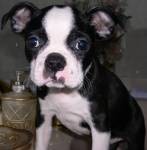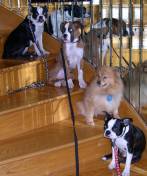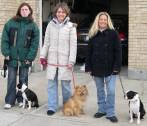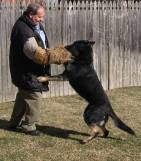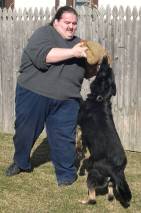There are five important principles one must keep in mind when training dogs:
5. Correction
6. KNOW HOW
The most fundamental principle in dog training is that the handler must know how each maneuver, act, technique, method and position is accomplished before he/she can properly train the dog.
There are standards of performance described for each training exercise and the dog handler must adhere to the proper methods and techniques so that these standards are achieved.
The handler must conscientiously apply all the principles with interest, enthusiasm and a desire to attain perfection. The handler must demand complete obedience from the dog at all times.
If the handler is negligent in the training procedures, the results are reflected in the dog’s performance. Therefore, it is essential that the handler possess personal discipline. This is especially true during the time that you are applying the principle of repetition.
The handler must conscientiously apply all the principles with interest, enthusiasm and a desire to attain perfection. The handler must demand complete obedience from the dog at all times.
If the handler is negligent in the training procedures, the results are reflected in the dog’s performance. Therefore, it is essential that the handler possess personal discipline. This is especially true during the time that you are applying the principle of repetition.
REPETITION
The method by which dogs learn and become proficient in performing a task is repetition. It is essential that the dog be given the same command over and over again until the desired
response is obtained. However, both the handler and the dog can lose efficiency by practicing any one command too much during one period. After practicing a command for 4 or 5 minutes,
it is best to move on to another command. If this is not possible, at least 10 minutes should elapse before resuming the practice of the original command.In the early stages of training, it is more important to show the dog what to do when given a
particular command. If necessary, the dog must be put into the proper position. Repeat the procedure as often as necessary until the dog learns what to do when given given the command. Never allow the dog to assume a position incorrectly. If it begins to make an incorrect movement, correct it immediately. Then, begin the exercise again, making sure the dog does not make the same mistake.
response is obtained. However, both the handler and the dog can lose efficiency by practicing any one command too much during one period. After practicing a command for 4 or 5 minutes,
it is best to move on to another command. If this is not possible, at least 10 minutes should elapse before resuming the practice of the original command.In the early stages of training, it is more important to show the dog what to do when given a
particular command. If necessary, the dog must be put into the proper position. Repeat the procedure as often as necessary until the dog learns what to do when given given the command. Never allow the dog to assume a position incorrectly. If it begins to make an incorrect movement, correct it immediately. Then, begin the exercise again, making sure the dog does not make the same mistake.
PATIENCE
One of the most important requirements of a dog trainer or handler is patience. To make a dog perform the same exercise repeatedly, until it is properly executed, is a task that requires the ultimate in self-control. When a handler loses his or her temper, they have lost control and this confuses the dog. Patience along with firmness results in a better trained dog
PRAISE
The dog trainer who displays patience can motivate the dog properly through praise. Whenever the dog successfully executes a command, even if its performance takes more time than expected, always reward it with a pat on the head or praise it in some other way. The dog is anxious to please its trainer, and the trainer should respond by praising the dog lavishly. When it is praised highly, the dog senses that it has done the correct thing and does it more readily the next time the same command is given. Several effective methods are used to praise a dog. Kind words often do the trick. One handler might prefer to pat the dog each time he/she wishes to reward it. Another handler might allow the dog a few minutes in which to romp and play, or he/she may allow the dog to perform its favorite exercises. Still another handler may apply a combination of these methods of praise.
Each dog requires a special method. Each handler must determine which method of praise best suits the individual dog and this can be determined during the handler’s early association with the dog. If the dog trainer is to maintain the dog’s enthusiasm for work, each training period must be concluded with petting, praise and encouragement. When the dog’s performance of the training exercise does not warrant praise, allow it to perform a short
exercise which it already knows thoroughly and does well so that it can earn a reward. Although the dog must be amply rewarded for those exercises performed correctly, it must be corrected when its performance is not satisfactory.
exercise which it already knows thoroughly and does well so that it can earn a reward. Although the dog must be amply rewarded for those exercises performed correctly, it must be corrected when its performance is not satisfactory.
CORRECTION
A dog does not understand right from wrong as humans do. Reward and correction are the means by which a dog is taught. If the dog does an exercise incorrectly, do not allow it to go uncorrected. Withholding praise, or the simple admonition,”NO!”, spoken reprovingly, or a sharp jerk on the leash, proves to be sufficient for correction purposes.TIMING is probably the most important factor in administering any form of correction.
Therefore, a reprimand, in whatever form, should be administered immediately when the incorrect act is performed. A dog cannot mentally connect a reprimand with an incorrect action committed some time before the reprimand.NEVER correct a dog for clumsiness, slowness in learning, or inability to understand what is expected of it. In these cases, correction slows down the dog’s training instead of accelerating
it.Observation, patience, self-control and discretion are essential in correction. If the dog makes a mistake, the handler may be at fault, and the handler should think for a second about why the mistake was made. Proper correction indicates proper thinking.
it.Observation, patience, self-control and discretion are essential in correction. If the dog makes a mistake, the handler may be at fault, and the handler should think for a second about why the mistake was made. Proper correction indicates proper thinking.
For dog training Contact Us at help@dogschoolny.com




